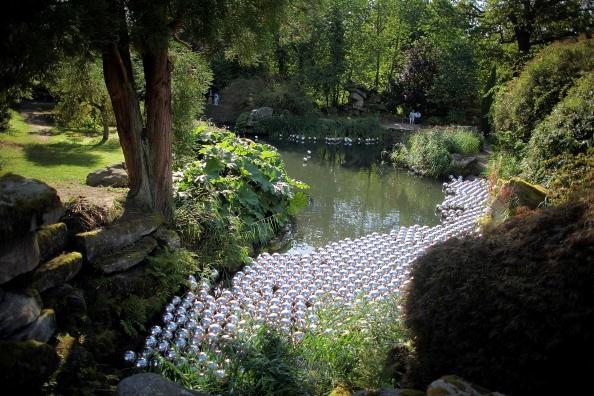With garden temperatures reaching their annual peak, providing you have kept good care of your filtration system and water quality, your garden pond should now be looking its very best, with algae-free waters glistening in the summer sun. But as many pond owners soon learn, it sometimes takes more than just crystal clear water to make a truly beautiful garden pond – choosing the right pond plants makes a massive difference too!
Your pond plants don’t just perform an aesthetic function – if you choose the right aquatic flora you are not only enhancing the look of your garden pond, but its bio-functionality too!
Oxygenation
Unlike the non-reactive features of your pond like pebbles and pond liner, your pond plants contribute to the oxygenation levels in your garden pond. Whether this contribution has a positive or negative effect on oxygen levels often depends on your choice of plant and your management of them.
For most ponds, higher oxygen levels are preferable, helping to reduce algae levels and promote an oxygen-rich environment for your fish. Choose floating/submerged plants like a little Starwort (Callitriche Verna), which provides surface cover, depriving algae of their sunlight and helping to reduce waste accumulation in your garden pond. It looks very natural just below the surface, but it is still best to keep on top of its growth so that it doesn’t get out of hand, adding more detritus to your pond.
You can enjoy flowering varieties of oxygenators too, like Water Violets, a.k.a. Featherfoil (Hottonia Palustris), that produce a lilac-colored flower from May through July, sprucing up your pond’s colour. You might also try Water Crowfoot (Ranunculus Aquatilis) which produces a similar flower to Water Violet, or Elodea Crispa, also known as Goldfish Weed, Curly Pond Weed, and Lagrosiphon.
Marginal Pond Plants
It’s not just about those plants that create a central feature in your garden pond – plants that border the edges can really add to the overall beauty and functionality of your garden oasis. Usually planted in pots and submerged to a depth of 1 or 2 inches from the rim of the pot, these plants thrive in your pond water, injecting colourful dynamics into your pond’s overall look. Take a look at great flowering plants like Water Forget-Me-Nots (Myosotis Scorpioides) that feature beautiful yet tiny flowers that compliment your garden pond.
Your marginal garden pond plants are likely to be the ones that provide the most year-round source of colour, like Bog Pimpernel (Anagallis Tenella) that flowers a beautiful pink-white from June through to September, or Marsh Marigold (Caltha Palustris) that explodes into a beautiful buttercup-yellow as early as March!
These marginal plants require a pond-shelf that holds them in position, so may require a little aquascaping before you can include them. But once they are in the garden pond, they not only look great but also help with biodiversity, becoming a safe haven for developing seedlings of various species that might otherwise get eaten if they were left in deeper water.
Floating Pond Plants
As the title suggests, this flora is free-floating in your pond and helps not only to provide your fish with a little cover from potential threats like Herons, but also prevents algae blooms by intercepting sunlight before it can reach algae in the water.
Providing your garden pond isn’t too exposed to the wind (in which case you might find that floating plants clump together on one side of your pond), floating plants look calm and serene. Try plants like Fairy Moss (Azolla Caroliniana) to complete your pond’s floating look, but don’t forget to check the size of the leaves in floating plants – some can get pretty big and you wouldn’t want them to take over.
When it comes to floating pond plants, you can even get winter flowering varieties: try Water Hawthorn (Aponogenton Distachyos) which will be dormant in the summer and produce white flowers January through May to replace your disappearing Frogbit (Hydrocharis morsus-ranae) that flowers between June and September.
Deep Water Plants
Deep water plants are some of the most beautiful garden pond plants available, offering some of the same advantages as floating plants and marginal plants, while also (in many cases) being great oxygenators.
Planted in pots like marginal plants, you can place these plant pots in deeper water. The stems of deep water plants are long and allow the flowering heads and leaves to float on the surface, but in a way that is secured under the water to prevent it from moving too far from your intended spot. Anchoring the deep water plant in this way maintains your desired look and helps absorb nutrients from the detritus at the bottom of your pond.
It is in this category that we find probably the most famous garden pond plant: The Water Lilly, simply beautiful. Try varieties like Nymphaea Shady Lady’s, a miniature pink water lily, or Nymphaea Aurora to give your pond some changing dynamics to watch and observe with pleasure.
When it comes to aquatic flora, the best results are usually attained by those aquarists who use a balanced approach, taking advantage of a variety of plant types to create a functioning ecosystem. To achieve this, research is always advised so you can strike the right balance and create a truly stunning yet functional aquatic garden.
This article was originally written and published by Mark Cropper for Swell, UK. He is a guest author for bigblogofgardening.com. For the original article and more information, please click HERE.
